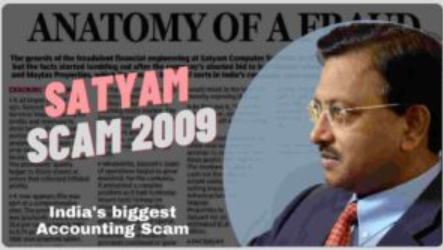
Satyam Scandal Case:
Unveiling India’s Biggest Corporate Fraud
Introduction
The Satyam Scandal, often dubbed
as "India's Enron," exposed one of the largest corporate frauds in
India's history. In January 2009, Ramalinga Raju, the founder of Satyam
Computer Services, confessed to manipulating financial statements, inflating
profits, and deceiving investors for years. This scandal rocked India's
corporate world, leading to enhanced regulatory reforms and raising critical
questions about corporate governance. This in-depth analysis examines the
origins, fraudulent mechanisms, legal proceedings, and the lasting impact of
the Satyam scandal on India’s financial and regulatory landscape.
Background of Satyam Computer
Services
1. Rise of Satyam: A Leading
IT Giant
Founded in 1987 in Hyderabad,
Satyam Computer Services Ltd. emerged as one of India’s largest IT outsourcing
firms. It provided services to global clients, including Fortune 500 companies,
and was listed on the Bombay Stock Exchange (BSE), National Stock Exchange
(NSE), and the New York Stock Exchange (NYSE).
- By 2008, Satyam had over 50,000 employees and
a market capitalization exceeding $7 billion.
- It was ranked among the top four IT
companies in India, alongside TCS, Infosys, and Wipro.
- The firm won multiple awards for corporate
excellence, including recognition from the Harvard Business School for
innovation.
2. The Initial Red Flags and
Questionable Decisions
Despite its rapid growth, signs
of financial irregularities began surfacing:
- December 2008: Satyam attempted to acquire
Maytas Infrastructure and Maytas Properties, two firms owned by the Raju
family, for $1.6 billion. Shareholders vehemently opposed the
move, leading to the cancellation of the deal within hours.
- Investigations revealed glaring
discrepancies in Satyam’s reported revenue, profits, and cash
reserves.
The Unraveling of the Fraud
1. Ramalinga Raju’s Confession
On January 7, 2009,
Ramalinga Raju shocked the corporate world by admitting to inflating Satyam’s
financial statements
by ₹7,136 crores ($1.5 billion). His confession letter to the board
detailed:
- Overstated revenue and profits for several
years.
- Fictitious bank balances amounting to ₹5,040
crores ($1 billion).
- Manipulated invoices and inflated operational
margins.
- The lack of actual cash reserves, contrary to
financial statements.
Raju described his actions
as "riding a tiger, not knowing how to get off without being
eaten."
2. Modus Operandi: How the
Fraud Was Executed
The Satyam fraud was
sophisticated, involving multiple deceptive practices:
A. Falsified Financial
Statements
- Fake invoices were generated to show non-existent
revenues.
- Profits were artificially inflated to attract
investors and boost stock prices.
B. Fabricated Bank Balances
- False cash reserves were recorded to match inflated
revenues.
- Forged fixed deposit receipts were shown as liquid
assets.
C. Insider Trading and Stock
Manipulation
- Raju and his associates sold millions of
shares before disclosing the fraud.
- The promoters offloaded their stakes at
high prices, cashing in before the scandal broke.
Regulatory and Legal Actions
1. Immediate Aftermath:
Government Intervention
Following Raju’s confession, the
Indian government acted swiftly:
- The Ministry of Corporate Affairs (MCA) dismissed
Satyam’s board and appointed a new one.
- The Central Bureau of Investigation (CBI),
Enforcement Directorate (ED), and SEBI launched extensive
investigations.
- The firm was placed under the scanner for corporate
fraud, embezzlement, and misrepresentation.
2. Arrests and Legal
Proceedings
- January 9, 2009: Ramalinga Raju, his brother
Rama Raju, and CFO Vadlamani Srinivas were arrested.
- Charges included:
- Criminal conspiracy (IPC Section 120B).
- Cheating and forgery (IPC Section 420, 468, 471).
- Insider trading and financial fraud (SEBI Act,
Companies Act).
3. Convictions and Sentencing
- April 2015: A special CBI court
sentenced Ramalinga Raju and nine others to seven
years in prison.
- ₹5.5 crore fine was imposed on Raju for
corporate fraud.
- The Supreme Court later granted him bail, citing
legal technicalities.
Impact on Corporate Governance
and Regulations
1. Strengthening of SEBI and
Corporate Laws
- SEBI introduced stricter disclosure norms and
forensic audits for listed companies.
- The Companies Act, 2013, incorporated
provisions for independent directors, whistleblower protections,
and improved corporate governance.
2. Acquisition by Tech
Mahindra
- In April 2009, Tech Mahindra
acquired a 31% stake in Satyam for ₹1,756 crores and
rebranded it as Mahindra Satyam.
- In 2013, Mahindra Satyam merged
with Tech Mahindra, fully absorbing the company.
Lessons Learned from the
Satyam Scandal
- Corporate Transparency: Need for real-time
audits and stronger regulatory oversight.
- Ethical Leadership: Importance of a
corporate culture promoting ethics and accountability.
- Investor Awareness: Need for due diligence
before investing in seemingly high-growth companies.
Conclusion: A Turning Point
for Indian Corporate Governance
The Satyam scandal remains
a landmark case in corporate fraud, significantly influencing India's
regulatory framework. While the fraud shook investor confidence,
it also led to major reforms ensuring greater
accountability, transparency, and investor protection. The scandal’s legacy
continues to serve as a case study in corporate governance,
reminding businesses and regulators of the perils of unchecked financial
malpractice.
FAQs
- What was the main fraud in the Satyam scandal?
- Satyam inflated its revenue, profits, and cash
reserves through fraudulent financial statements.
- Who was responsible for the Satyam scandal?
- Founder Ramalinga Raju, along with key executives,
orchestrated the fraud.
- What were the consequences of the Satyam scam?
- Legal action against executives, enhanced
corporate governance laws, and Satyam’s acquisition by Tech Mahindra.
- How did the Indian government respond to the
Satyam scandal?
- The government dismissed the board, ordered a
forensic audit, and implemented stricter financial regulations.
- What are the key takeaways from the Satyam fraud
case?
- Importance of financial transparency, ethical
leadership, and robust regulatory frameworks in preventing corporate
fraud.
